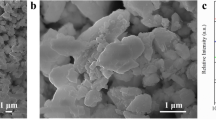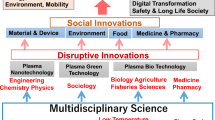Abstract
In this work, we performed the comparative study of plasma parameters, steady-state gas phase compositions and Si reactive-ion etching kinetics in CF4 + O2 + Ar, CHF3 + O2 + Ar and C4F8 + O2 + Ar gas mixtures with variable O2/Ar component ratios. It was found that the substitution of Ar for O2 (a) did not disturb the well-known correlation between the polymerizing ability and the F/C ratio in the original fluorocarbon molecule; (b) causes similar changes in electrons- and ions-related plasma parameters (electron temperature, plasma density, ion bombardment energy); and (c) always suppresses densities of polymerizing radicals and reduces the polymer film thickness. At the same time, the specific effects of oxygen on F atom kinetics result in sufficient differences in their densities and fluxes. It was shown that the dominant etching mechanism for Si in all three gas systems is the chemical etching pathway provided by F atoms (since the contribution of physical sputtering is below 10%) while measured etching rates do not follow the behavior of F atom flux. The phenomenological analysis of heterogeneous process kinetics allowed one to suggest factors influencing the effective reaction probability. These are either the transport of F atoms through thick polymer film (in the case of high-polymerizing C4F8 + O2 + Ar plasma) or heterogeneous reactions with a participation of oxygen atoms under the condition of thin or non-continuous polymer film (in the case of low-polymerizing CF4 + O2 + Ar plasma).





Similar content being viewed by others
References
Sze SM (1988) VLSI technology. McGraw-Hill, New York
Sugano T (1990) Applications of plasma processes to VLSI technology. Wiley, New York
Rooth JR (1995) Industrial plasma engineering. IOP Publishing LTD, Philadelphia
Wlof S, Tauber RN (2000) Silicon processing for the VLSI era. Volume 1. Process technology. Lattice Press, New York
Lieberman MA, Lichtenberg AJ (1994) Principles of plasma discharges and materials processing. Wiley, New York
Roosmalen AJ, Baggerman JAG, Brader SJH (1991) Dry etching for VLSI. Plenum Press, New-York
Kimura T, Noto M (2006) Experimental study and global model of inductively coupled CF4/O2 discharges. J Appl Phys 100:063303
Kimura T, Ohe K (1999) Probe measurements and global model of inductively coupled Ar/CF4 discharges. Plasma Sour Sci Technol 8:553
Chun I, Efremov A, Yeom GY, Kwon K-H (2015) A comparative study of CF4/O2/Ar and C4F8/O2/Ar plasmas for dry etching applications. Thin Solid Films 579:136
Efremov A, Lee J, Kim J (2017) On the control of plasma parameters and active species kinetics in CF4 + O2 + Ar gas mixture by CF4/O2 and O2/Ar mixing ratios. Plasma Chem Plasma Process 37:1445
Ho P, Johannes JE, Buss RJ (2001) Modeling the plasma chemistry of C2F6 and CHF3 etching of silicon dioxide, with comparisons to etch rate and diagnostic data. J Vac Sci Technol B 19:2344
Efremov AM, Murin DB, Kwon K-H (2018) Parameters of plasma and kinetics of active particles in CF4(CHF3) + Ar mixtures of a variable initial composition. Russ Microlectron 47:371
Efremov AM, Murin DB, Kwon K-H (2020) Plasma parameters and kinetics of active particles in the mixture CHF3 + O2 + Ar. Russ Microlectron 49:233
Kokkoris G, Goodyear A, Cooke M, Gogolides E (2008) A global model for C4F8 plasmas coupling gas phase and wall surface reaction kinetics. J Phys D Appl Phys 41:195211
Rauf S, Ventzek PL (2002) Model for an inductively coupled Ar/c-C4F8 plasma discharge. J Vac Sci Technol A 20:14
Lim N, Efremov A, Kwon K-H (2019) Gas-phase chemistry and etching mechanism of SiNx thin films in C4F8 + Ar inductively coupled plasma. Thin Solid Films 685:97–110
Lee BJ, Efremov A, Nam Y, Kwon K-H (2020) Plasma parameters and silicon etching kinetics in C4F8 + O2 + Ar gas mixture: effect of component mixing ratios. Plasma Chem Plasma Process 40:1365–1380
Schaepkens M, Standaert TEFM, Rueger NR, Sebel PGM, Oehrlein GS, Cook JM (1999) Study of the SiO2-to-Si3N4 etch selectivity mechanism in inductively coupled fluorocarbon plasmas and a comparison with the SiO2-to-Si mechanism. J Vac Sci Technol A 17:26
Matsui M, Tatsumi T, Sekine M (2001) Relationship of etch reaction and reactive species flux in C4F8/Ar/O2 plasma for SiO2 selective etching over Si and Si3N4. J Vac Sci Technol A 19:2089
Standaert TEFM, Hedlund C, Joseph EA, Oehlein GS, Dalton TJ (2004) Role of fluorocarbon film formation in the etching of silicon, silicon dioxide, silicon nitride, and amorphous hydrogenated silicon carbide. J Vac Sci Technol A 22:53
Kastenmeier BEE, Matsuo PJ, Oehrlein GS (1999) Highly selective etching of silicon nitride over silicon and silicon dioxide. J Vac Sci Technol A 17:3179
Lele C, Liang Z, Linda X, Dongxia L, Hui C, Tod P (2009) J Semicond 30:033005
Li X, Ling L, Hua X, Fukasawa M, Oehrlein GS, Barela M, Anderson HM (2003) Effects of Ar and O2 additives on SiO2 etching in C4F8-based plasmas. J Vac Sci Technol A 21:284
Son J, Efremov A, Chun I, Yeom GY, Kwon K-H (2014) On the LPCVD-formed SiO2 etching mechanism in CF4/Ar/O2 inductively coupled plasmas: effects of gas mixing ratios and gas pressure. Plasma Chem Plasma Process 34:239
Lee J, Efremov A, Yeom GY, Lim N, Kwon K-H (2015) Application of Si and SiO2 etching mechanisms in CF4/C4F8/Ar inductively coupled plasmas for nanoscale patterns. J Nanosci Nanotechnol 15:8340
Efremov A, Murin D, Kwon K-H (2020) Concerning the effect of type of fluorocarbon gas on the output characteristics of the reactive-ion etching process. Russ Microlectron 49:157
Shun’ko EV, (2008) Langmuir probe in theory and practice. Universal Publishers, Boca Raton
Vasenkov AV, Li X, Oehlein GS, Kushner MJ (2004) Properties of c-C4F8 inductively coupled plasmas. II. Plasma chemistry and reaction mechanism for modeling of Ar/c-C4F8/O2 discharges. J Vac Sci Technol A 22:511
Lee C, Lieberman MA (1995) Global model of Ar, O2, Cl2, and Ar/O2 high density plasma discharges. J Vac Sci Technol A 13:368
Hsu CC, Nierode MA, Coburn JW, Graves DB (2006) Comparison of model and experiment for Ar, Ar/O2 and Ar/O2/Cl2 inductively coupled plasmas. J Phys D Appl Phys 39:3272
Chistophorou LG, Olthoff JK (2004) Fundamental electron interactions with plasma processing gases. Springer, New York
Efremov A, Lee J, Kwon K-H (2017) A comparative study of CF4, Cl2 and HBr + Ar inductively coupled plasmas for dry etching applications. Thin Solid Films 629:39
Proshina O, Rakhimova TV, Zotovich A, Lopaev DV, Zyryanov SM, Rakhimov AT (2017) Multifold study of volume plasma chemistry in Ar/CF4 and Ar/CHF3 CCP discharges. Plasma Sources Sci Technol 26:075005
Takahashi K, Hori M, Goto T (1994) Characteristics of fluorocarbon radicals and CHF3 molecule in CHF3 electron cyclotron resonance downstream plasma. Jpn J Appl Phys 33:4745
Sasaki K, Kawai Y, Kadota K (1999) Determination of fluorine atom density in reactive plasmas by vacuum ultraviolet absorption spectroscopy at 95.85 nm. Rev Sci Instrum 70:76–81
Kim DK, Kim YK, Lee H (2007) A study of the role of HBr and oxygen on the etch selectivity and the post-etch profile in a polysilicon/oxide etch using HBr/O2 based high density plasma for advanced DRAMs. Mater Sci Semicond Process 10:41
d’Agostino R, Flamm DL (1981) Plasma etching of Si and SiO2 in SF6-O2 mixtures. J Appl Phys 52:162
Knizikevicius R (2010) Simulations of Si and SiO2 Etching in SF6 + O2 Plasma. Acta Phys Pol A 117:478
Mellhaoui X, Dussarta R, Tillocher T, Lefaucheux P, Ranson P (2005) SiOxFy passivation layer in silicon cryoetching. J Appl Phys 98:104901
Pereira J, Pichon LE, Dussart R, Cardinaud C, Duluard CY, Oubensaid EH, Lefaucheux P, Boufnichel M, Ranson P (2009) In situ x-ray photoelectron spectroscopy analysis of SiOxFy passivation layer obtained in a SF6/O2 cryoetching process. Appl Phys Lett 94:071501
Mullins CB, Coburn JW (1994) Ion-beam-assisted etching of Si with fluorine at low temperatures. J Appl Phys 76:7562
Chevolleau T, Tessier PY, Cardinaud C, Turban G (1997) Etching of Si at low temperatures using a SF6 reactive ion beam: Effect of the ion energy and current density. J Vac Sci Technol A 15:2661
Yeom GY, Kushner MJ (1990) Si/SiO2 etch properties using CF4 and CHF3 in radio frequency cylindrical magnetron discharges. Appl Phys Lett 56:857
Gatzert C, Blakers AW, Deenapanray PNK, Macdonald D, Auret FD (2006) Investigation of reactive ion etching of dielectrics and Si in CHF3/O2 or CHF3/Ar for photovoltaic applications. J Vac Sci Technol A 24:1857
Acknowledgements
This work was supported by the Industrial Technology Innovation Program (20009818, Development of plasma realtime process monitoring sensor and process simulation technology) funded by the Ministry of Trade, Industry and Energy (MOTIE, Republic of Korea) (N. Lim and K.-H. Kwon).
Author information
Authors and Affiliations
Corresponding author
Additional information
Publisher's Note
Springer Nature remains neutral with regard to jurisdictional claims in published maps and institutional affiliations.
Rights and permissions
About this article
Cite this article
Lim, N., Efremov, A. & Kwon, KH. A Comparison of CF4, CHF3 and C4F8 + Ar/O2 Inductively Coupled Plasmas for Dry Etching Applications. Plasma Chem Plasma Process 41, 1671–1689 (2021). https://doi.org/10.1007/s11090-021-10198-z
Received:
Accepted:
Published:
Issue Date:
DOI: https://doi.org/10.1007/s11090-021-10198-z




